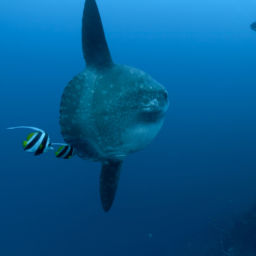I’d never heard of the sleepy diving village of Amed on the east coast of Bali, but the buzz from other divers soon led me there. Amed is a magical place, with volcanic black-sand beaches and gin-clear seas, nestled in the shadow of a picture-perfect volcano. Its single street is lined with dive centers and local restaurants, while traditional Balinese fishing boats grace the shore. Just off the beach is beautiful snorkeling and diving; walking into the sea is like walking into a bath, both in temperature and transparency. The reef begins after just a few feet and stretches along the coast in a riot of color and productivity. Even with all this to recommend it, Amed’s main attraction is its proximity to Tulamben, the final resting place of one of Southeast Asia’s most famous wrecks, the USS Liberty.
The USS Liberty began its life in June 1918, in New Jersey. Measuring 410 feet, and with a displacement of 13,130 tons, the Liberty served in the U.S. Navy during World War I as an animal-transport ship, moving cavalry horses to the front line in France. When the war ended, the ship was decommissioned, but returned to the military in 1940 as part of the U.S. Army defensive service. In 1942, a Japanese submarine torpedoed the ship, which was carrying cargo from Australia to the Philippines. The Liberty rapidly took on water, thwarting attempts to tow it to port. It was beached on the shore at Tulamben so that intact cargo could be salvaged. But this was not the end of the USS Liberty’s story. In 1963, the volcano that watches over Amed erupted, and violent tremors sent the ship off the beach and into the ocean, where it finally came to rest just feet from shore.
Since then, divers from all over the world have visited the Liberty, and I eagerly sought to join them when I arrived at Tulamben’s stony beach. The first thing to captivate me, though, was not the wreck, but the parking lot’s dive porters. Appearing from nowhere to help carry our gear to the water’s edge, the porters were impossibly petite Balinese women, each of whom balanced full crates of dive equipment — including cylinders — on their heads as if they were weightless. The Liberty is a shore-entry dive, and soon we were making our way awkwardly down the pebble beach and into the ocean. The wreck lies around 100 feet offshore, and within minutes it appeared ethereally out of the blue, the first glimpses of its skeletal structure causing me to speculate, as I always do, on how the ship must have looked in its heyday.
Almost 70 feet of visibility lent the dive a sense of the surreal, a vertiginous detachment that made me feel like a voyeur, observing the wreck in all its beauty from a place of weightless wonder. The bones of the wreck are undoubtedly spectacular, but the many creatures that now live there constitute one of the site’s main draws. The wreck’s many hollows and jutting spars provide a home to plentiful species of fish, from shifting shoals of mirrored silver dollars to hiding clusters of translucent glassfish. Titan triggerfish patrol the depths beyond, aggressively watching for any divers intruding upon their territory, while schools of sergeant majors and blue runners turn the water column into a veritable showcase of startling color. We saw a huge hawksbill turtle grazing on the ship’s algae-covered skeleton, and a large bumphead parrotfish cruising in the blue above its hull. A resident great barracuda patrols the waters around the wreck, and we saw it close to the surface near the end of the dive, its large body shimmering in the morning sun like shards of splintered glass. The highlight for me was discovering a tiny, juvenile octopus curled up in a crevice in the wall of the ship’s cargo hold, its fleshy body pulsating with all the colors of the rainbow.
After we made our way to shore I returned to Amed, delighted to have discovered that despite the many divers who visit it each year, the USS Liberty lives up to its reputation as one of the most beautiful wrecks in Southeast Asia, possibly more beautiful now even than when it sailed, its bones covered thickly with coral growth, twisting and transforming them into a masterpiece of nature’s reclaimed artistry.



